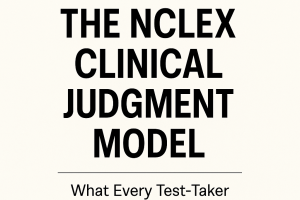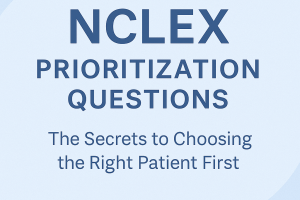Mental Health: Anxiety Disorders – A Guide for NCLEX Preparation

Anxiety disorders are among the most common mental health conditions encountered in clinical practice. As an NCLEX candidate, understanding anxiety disorders is essential for providing comprehensive mental health care. This blog post will explore the causes, symptoms, diagnosis, management, and nursing care of anxiety disorders, with a focus on their relevance for the NCLEX exam.
What Are Anxiety Disorders?
Anxiety disorders are mental health conditions characterized by excessive fear or worry that interferes with daily life. These disorders often involve physical symptoms such as increased heart rate, sweating, and restlessness. Anxiety disorders include generalized anxiety disorder (GAD), panic disorder, phobias, social anxiety disorder, and obsessive-compulsive disorder (OCD).
Types of Anxiety Disorders
- Generalized Anxiety Disorder (GAD):
- Persistent and excessive worry about a variety of topics.
- Symptoms last for at least six months and include restlessness, fatigue, difficulty concentrating, irritability, muscle tension, and sleep disturbances.
- Panic Disorder:
- Characterized by recurrent, unexpected panic attacks.
- Panic attacks are sudden episodes of intense fear or discomfort, often accompanied by physical symptoms like chest pain, palpitations, shortness of breath, dizziness, and sweating.
- Phobias:
- An intense, irrational fear of specific objects, situations, or activities.
- Common phobias include fear of heights (acrophobia), flying (aviophobia), or social situations (social anxiety disorder).
- Social Anxiety Disorder:
- Intense fear of social or performance situations, often leading to avoidance.
- Symptoms include fear of embarrassment, judgment, or scrutiny in social interactions.
- Obsessive-Compulsive Disorder (OCD):
- Characterized by intrusive thoughts (obsessions) and repetitive behaviors (compulsions).
- Common obsessions include fear of contamination, while compulsions may involve excessive cleaning or checking.
- Post-Traumatic Stress Disorder (PTSD):
- Can develop after exposure to a traumatic event.
- Symptoms include flashbacks, nightmares, hypervigilance, and avoidance of reminders of the trauma.
Causes of Anxiety Disorders
Anxiety disorders result from a combination of genetic, environmental, psychological, and neurobiological factors. Common causes include:
- Genetics: A family history of anxiety disorders can increase the likelihood of developing one.
- Brain Chemistry: Imbalances in neurotransmitters such as serotonin, norepinephrine, and gamma-aminobutyric acid (GABA) may contribute to anxiety.
- Environmental Factors: Stressful or traumatic events, such as abuse, loss, or major life changes, can trigger anxiety disorders.
- Personality: Individuals with certain personality traits, such as perfectionism or low self-esteem, are more prone to anxiety.
Symptoms of Anxiety Disorders
The symptoms of anxiety disorders vary depending on the type but generally include:
- Emotional Symptoms:
- Excessive worry or fear
- Feeling on edge or restless
- Irritability
- Physical Symptoms:
- Rapid heartbeat (tachycardia)
- Sweating
- Shortness of breath
- Muscle tension
- Fatigue
- Sleep disturbances
- Cognitive Symptoms:
- Difficulty concentrating or focusing
- Racing thoughts
- Overthinking situations or future events
- Catastrophic thinking (expecting the worst)
Diagnosis of Anxiety Disorders
Diagnosing anxiety disorders involves a thorough assessment, including a physical examination, psychological evaluation, and diagnostic criteria from the Diagnostic and Statistical Manual of Mental Disorders (DSM-5). Healthcare providers must rule out medical conditions that may mimic anxiety symptoms, such as hyperthyroidism or cardiac issues.
Management of Anxiety Disorders
The treatment of anxiety disorders typically involves a combination of psychotherapy, medications, and lifestyle changes.
Psychotherapy
- Cognitive Behavioral Therapy (CBT):
- The most effective form of therapy for anxiety disorders.
- CBT helps patients identify and challenge irrational thought patterns (cognitive distortions) and develop healthier coping mechanisms.
- Exposure Therapy:
- Involves gradual exposure to feared situations or objects to reduce anxiety over time.
- Particularly effective for phobias and OCD.
- Mindfulness-Based Therapy:
- Focuses on staying present and reducing rumination.
- Techniques like deep breathing, meditation, and progressive muscle relaxation help manage anxiety.
Medications
- Selective Serotonin Reuptake Inhibitors (SSRIs):
- Commonly prescribed antidepressants, such as fluoxetine and sertraline, that increase serotonin levels in the brain.
- Often the first-line treatment for anxiety disorders.
- Benzodiazepines:
- Fast-acting anti-anxiety medications like lorazepam and diazepam.
- Used for short-term relief due to the risk of dependence.
- Beta-Blockers:
- Medications such as propranolol that help control physical symptoms of anxiety (e.g., rapid heart rate).
- Often used in social anxiety disorder for performance-related anxiety.
- Buspirone:
- A non-benzodiazepine anti-anxiety medication that is effective for GAD.
- Tricyclic Antidepressants (TCAs) and Monoamine Oxidase Inhibitors (MAOIs):
- Less commonly used due to side effects but may be prescribed for treatment-resistant anxiety.
Lifestyle Modifications
- Exercise: Regular physical activity can reduce stress and improve mood.
- Healthy Diet: Eating a balanced diet and avoiding caffeine and alcohol can help manage anxiety.
- Sleep Hygiene: Establishing a regular sleep routine can improve overall well-being and reduce anxiety symptoms.
- Stress Management: Techniques like yoga, meditation, and journaling can be effective in managing anxiety.
Nursing Care for Anxiety Disorders
Nurses play a crucial role in caring for patients with anxiety disorders. Key interventions include:
- Assessing Anxiety Levels: Use standardized tools like the Hamilton Anxiety Rating Scale to assess the severity of anxiety.
- Providing Emotional Support: Establish trust and rapport with the patient, offering a safe and non-judgmental environment.
- Promoting Relaxation Techniques: Teach patients techniques such as deep breathing, progressive muscle relaxation, and guided imagery to manage acute anxiety.
- Administering Medications: Monitor for therapeutic effects and side effects of anti-anxiety medications. Educate patients on the importance of medication adherence.
- Encouraging Participation in Therapy: Support patients in attending therapy sessions and engaging in self-care practices.
- Educating Patients and Families: Provide information about anxiety disorders, treatment options, and coping strategies. Educate family members on how to support the patient.
Sample NCLEX Questions
Question 1
A nurse is caring for a patient with generalized anxiety disorder (GAD). The patient reports difficulty sleeping and excessive worry about work. Which intervention is most appropriate for the nurse to implement?
A. Encourage the patient to drink coffee before bed to improve alertness.
B. Teach the patient relaxation techniques such as deep breathing.
C. Suggest the patient avoid physical activity during the day.
D. Encourage the patient to stay awake until they feel exhausted.
Answer: B. Teach the patient relaxation techniques such as deep breathing.
Question 2
A patient with panic disorder is experiencing a panic attack in the emergency department. Which action should the nurse take first?
A. Administer oxygen at 2 liters per minute.
B. Encourage the patient to focus on slow, deep breaths.
C. Ask the patient to describe the events leading to the attack.
D. Prepare the patient for an electrocardiogram (ECG).
Answer: B. Encourage the patient to focus on slow, deep breaths.
Question 3
A patient with obsessive-compulsive disorder (OCD) frequently washes their hands due to a fear of contamination. Which nursing intervention is most appropriate?
A. Encourage the patient to wash their hands as often as they feel necessary.
B. Allow the patient to avoid handwashing to reduce anxiety.
C. Help the patient gradually reduce the number of times they wash their hands.
D. Provide gloves for the patient to wear to prevent contamination.
Answer: C. Help the patient gradually reduce the number of times they wash their hands.
NCLEX Preparation Tips for Anxiety Disorders
- Understand the Types: Be familiar with the different anxiety disorders, their symptoms, and treatment options.
- Know the Medications: Focus on SSRIs, benzodiazepines, and other common medications used to treat anxiety.
- Review Nursing Interventions: Practice nursing care strategies for managing acute anxiety and long-term treatment plans.
- Practice Therapeutic Communication: Ensure you are well-versed in providing emotional support and encouraging coping mechanisms for patients with anxiety.
Conclusion
Anxiety disorders are prevalent mental health conditions that require a comprehensive understanding of their causes, symptoms, diagnosis, and management. As a future nurse, your ability to provide compassionate care and support to patients with anxiety is critical for their recovery and well-being. Preparing for anxiety disorders on the NCLEX exam will equip you with the skills and knowledge necessary to make a positive impact in mental health care.






